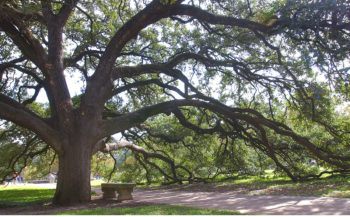Century Oak Given “Famous Tree Of Texas” Designation By Texas Forest Service

Aggies for decades have considered the tree famous. Now, the Texas Forest Service (TFS) agrees that the “Century Oak” in the heart of the Texas A&M University campus warrants “Famous Tree of Texas” designation.
Better known on campus as the “Century Tree,” the stately live oak dominates a large section of Texas A&M’s Academic Plaza where one of the campus’ most identifiable landmark buildings also stands.
No one knows exactly how old the tree is, but consensus is that it dates back to about 1900 — not too long after the 1876 opening of Texas A&M as the state’s first public institution of higher learning. Many of its branches have grown so long and become so heavy that they now rest on the ground.
The Century Tree has extra special meaning to hundreds of Aggies who over decades have proposed to their fiancés in the pathway that runs between some of its drooping branches. More often than not, the young man proposing to his bride-to-be is a member of the Corps of Cadets.
The “Famous Tree of Texas” designation is reserved for “an elite group of trees that have “˜witnessed exciting times in Texas frontier history’ and are alive today,” Gretchen Riley, the program’s coordinator, said in a letter notifying Texas A&M President R. Bowen Loftin of the campus tree’s inclusion in the select list.
Riley, staff forester for the Texas Forest Service, which is a member of The Texas A&M University System, explained that TFS initially included 87 “famous trees” in a book published in 1970.
“Sadly, Texas has lost many of these historic trees to the ravages of time,” she noted “Only 56 remain.”
The Century Tree is one of only three trees added to the registry in the past 40 years, Riley said. She added it is the only formally designated “Famous Tree of Texas” located in the heart of a campus but pointed out that another, dubbed the “Kissing Oak,” is on land owned and utilized by Texas State University in San Marcos.
Riley said photos and information about the trees in the TFS registry can be accessed here, with a picture of the Century Tree and its story soon to be added.
Although the Century Tree is the only tree on the Texas A&M campus with formal TFS designation, there are scores of others with special meanings to Aggies and family members and friends of deceased former students. Twelve live oaks have been plants along a thoroughfare near the Bonfire Memorial to honor the memories of the 12 Aggies who died as a result of the collapse of the bonfire stack during construction in 1999. Also, the university’s main drill field has traditionally been encircled by live oaks planted in memory of the 53 Aggies who died in combat during World War I. They were planted 90 years ago and, in 2008 university personnel replaced 25 that had died over a period of several years.
In all, more than 10,000 trees grace Texas A&M’s 5,200-acre campus — one of the largest campuses in the nation.
Media contact: Lane Stephenson, Texas A&M News & Information Services.





